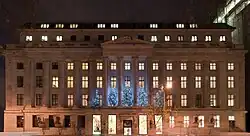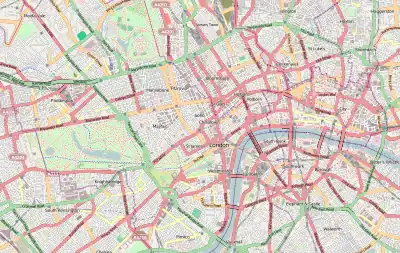 | |
 | |
 Location within Central London | |
| Established | 2007 |
|---|---|
| Location | Euston Road London, NW1 United Kingdom |
| Coordinates | 51°31′33″N 0°08′02″W / 51.525944°N 0.133889°W |
| Type | Museum, library |
| Collections | history of medicine |
| Visitors | 550,000 per annum, as of 2013[1] |
| Founder | Henry Wellcome |
| Director | Melanie Keen |
| Public transit access | |
| Website | wellcomecollection |
Wellcome Collection is a museum and library based at 183 Euston Road, London, England, displaying a mixture of medical artefacts and original artworks exploring "ideas about the connections between medicine, life and art".[2] Founded in 2007, the Wellcome Collection attracts over 550,000 visitors per year.[1] The venue offers contemporary and historic exhibitions and collections, the Wellcome Library, a café, a bookshop and conference facilities. In addition to its physical facilities, Wellcome Collection maintains a website of original articles and archived images related to health.[3]
History and development


Wellcome Collection is part of the Wellcome Trust, founded by Sir Henry Solomon Wellcome (1853–1936). An extensive and enthusiastic traveller, Henry Wellcome amassed a huge collection of books, paintings and objects on the theme of historical development of medicine worldwide. There was an earlier Wellcome Historical Medical Museum at 54a Wigmore Street, housing artefacts from around the world.[4]
The Wellcome Trust moved its administrative offices into their new Gibbs Building (designed for the Trust by Michael Hopkins and Partners) on the adjoining site in Euston Road, completed 2004: thereby creating an opportunity for a new public venue in the old Wellcome Building. The collection opened to the public in June 2007.[5]
Due to its historical holdings, the Wellcome Collection is a member of The London Museums of Health & Medicine group.[6]
Having been open since 2007, Wellcome Collection re-opened with additional public spaces in October 2015.[7]
Melanie Keen took over as the director of the Wellcome Collection in 2019.[8]
Wellcome Library

The Wellcome Library provides access to collections of books, manuscripts, archives, films and pictures on the history of medicine from the earliest times to the present day.[9]
The Hub
Located on the 5th floor of the Collection, The Hub is a space for researchers to collaborate, which "brings together different voices and expertise as part of an experiment to see what new knowledge can be created".[10]
The first residents of The Hub, Hubbub, explored the dynamics of "rest, noise, tumult, activity and work" from October 2014 to July 2016.[11]
In October 2016-July 2018 Created Out of Mind, a group exploring dementia and the arts began their residency.[12] "Many of the group’s core members came from the Dementia Research Centre (DRC) at University College London. The team aimed to explore what dementia means to all of us, as well as challenging definitions of the condition".[13]
From 2018 to 2020, award-winning creative arts company and charity Heart n Soul took up residency at The Hub "exploring ideas like ‘normality’ and the value of difference between us all".[14]
The Reading Room
Refurbished in 2015 as part of the Wellcome Collection's 2015 renovation,[7] the Reading Room is open to the public.
Collections

The collection is divided into several galleries. "Being Human" is a permanent exhibition opened in 2019 designed with the helped of disabled artists and activists within the frame of the social model of disability, making it one of the world's most accessible galleries.[15] "Being Human" explores what it means to be human in the 21st century with a focus on personal stories, and is split into four parts: genetics, minds & bodies, infection, and environmental breakdown.[16] It includes art by Yinka Shonibare CBE, Latai Taumoepeau, Kia LaBeija, Mary Beth Heffernan, and Isaac Murdoch's "Water is Life" banner designed for the Standing Rock protests.[17]
The museum previously hosted the "Medicine Man" which was a permanent exhibition displaying a small part of Henry Wellcome's collection. The exhibition closed permanently on 27th November 2022 after running for fifteen years. While part of an ongoing programme to update how the collection is displayed, the closure was perceived to be a result of concerns over "racist, sexist and ableist theories and language".[18][19]
The main exhibition space hosts a changing programme of events and exhibitions. The space has included work by Felicity Powell and Bobby Baker.
The building foyer and public areas usually include a 1950 work by Pablo Picasso[20] (originally on a wall in John Desmond Bernal's flat in Torrington Square) and one by Anthony Gormley.[21] A figure by Marc Quinn[22] was originally lying unprotected on the stone floor, then moved inside a glass case, and is also not currently on view. The collection includes 17,500 magic-medical amulets, talismans and charms picked up by Henry Wellcome in Islamic North Africa and elsewhere in the world.[23]
Wellcome Collection is digitising and openly licensing its collection, as of January 2020, it had made over 40 million images[24] from 325,000 items (books, manuscripts, archives, artworks, audio and video material etc.) available on wellcomecollection.org and via a range of third-party services.
References
- 1 2 "Wellcome Collection London Transformation / Wilkinson Eyre Architects". 16 June 2015.
- ↑ Art Fund. "Museum of the Year". Art Fund.
- ↑ "Stories". Wellcome Collection. Retrieved 30 March 2020.
- ↑ "Error". wellcome.ac.uk.
- ↑ Photograph: Felix Clay/freelance (20 June 2007). "The Wellcome Collection". The Guardian.
- ↑ "Medical Museums". medicalmuseums.org. Retrieved 26 August 2016.
- 1 2 Houghton, Lauren (23 February 2015). "Wellcome Collection to reopen after £17.5m refurb". Retrieved 26 March 2016.
- ↑ "Melanie Keen appointed Director of Wellcome Collection". Wellcome Collection. Retrieved 8 December 2022.
- ↑ "Wellcome Library - Home". wellcomelibrary.org.
- ↑ "The Hub at Wellcome Collection".
- ↑ "Hubbub 'about' page".
- ↑ "Exploration of dementia announced as second project of The Hub at Wellcome Collection". 24 March 2016.
- ↑ "Created Out Of Mind".
- ↑ "Heart n Soul at The Hub".
- ↑ Marshall, Alex (6 September 2019). "Is This the World's Most Accessible Museum?". The New York Times.
- ↑ "Being Human". Wellcome Collection.
- ↑ "Being Human Captions". Wellcome Collection.
- ↑ "Statement on the closure of our Medicine Man gallery". Wellcome Collection. Retrieved 1 January 2023.
- ↑ "Wellcome Collection closes 'racist, sexist and ableist' Medicine Man display". BBC News. 27 November 2022. Retrieved 1 January 2023.
- ↑ "Bernal's Picasso Goes On Show In London At Wellcome Collection". culture24.org.uk.
- ↑ "Antony Gormley". Telegraph.co.uk. 13 March 2007. Archived from the original on 21 April 2013.
- ↑ White Cube. "Exhibitions - White Cube". whitecube.com.
- ↑ Bos, Gerrit (1 October 1995). "Medical and para-medical manuscripts in the Cambridge Genizah Collections". Med. Hist. 39 (4): 516–518. doi:10.1017/S0025727300060579. ISSN 0025-7273. OCLC 8139058359. PMC 1037050. (citing an article of Lawrence Conrad).
- ↑ "Wellcome Collection Digitisation Strategy" (PDF). January 2020.
